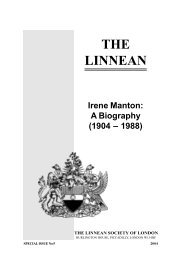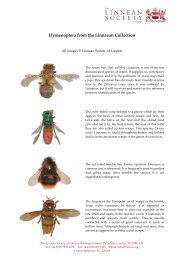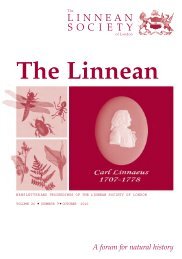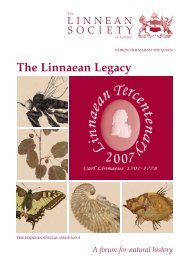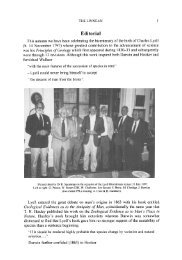Vol 25, no 3, October - The Linnean Society of London
Vol 25, no 3, October - The Linnean Society of London
Vol 25, no 3, October - The Linnean Society of London
You also want an ePaper? Increase the reach of your titles
YUMPU automatically turns print PDFs into web optimized ePapers that Google loves.
44<br />
THE LINNEAN 2009 VOLUME <strong>25</strong>(3)<br />
lying, there were in the clefts <strong>of</strong> the rocks a few Cacti. <strong>The</strong>se are supported by the dense<br />
clouds which generally rest on the land at this height… This is the first true desart I<br />
have ever seen; the effect on me was <strong>no</strong>t impressive…” (Keynes 1988: 345-346).<br />
Darwin’s unk<strong>no</strong>wn soil lichen is most likely Vermalicina tigrina (Spujt 1995,<br />
1996), described by Gerhard Follmann as Ramalina tigrina (Follmann 1966), 131<br />
years after its initial discovery, although <strong>no</strong> specimen <strong>of</strong> it has been found attributable<br />
to Darwin. His observations on the relationships <strong>of</strong> cloud, cacti and lichens, are the<br />
first I k<strong>no</strong>w <strong>of</strong>, <strong>of</strong> the “camanchaca” (the South American vernacular name for the<br />
cold coastal fog that sweeps in from the Pacific to drape the coastal ranges and their<br />
“cactus forests”) and its influence on lichen distribution in these fascinating fog-oases<br />
that are characteristic <strong>of</strong> the <strong>no</strong>rth <strong>of</strong> Chile and found also in Peru, Baja California and<br />
Namibia. Although in recent years, the characteristic North Chilean coastal lichen<br />
mycobiota has been in alarming decline (Follmann 1995), Darwin’s “lichen oasis”<br />
was rediscovered by Gerhard Follmann in the early 1990s when a few SW-facing<br />
clefts <strong>of</strong> the outer ridges <strong>of</strong> the coastal cordillera between 800 and 900 m, revealed<br />
large mats <strong>of</strong> soil lichens developed between sparse skeletons <strong>of</strong> the columnar cactus<br />
Eulychnia iquiquensis. Here, Darwin’s greenish lichen, V. tigrina, associates with<br />
Heterodermia leucomela, Ramalina celastri, R. cochlearis, R. peruviana, R. pilulifera,<br />
Roccellina suffruticosa and Xanthomendoza mendozae (Follmann 1994).<br />
8. Peru: <strong>The</strong> Beagle anchored at Callao on 19 July 1835 and Darwin stayed in<br />
Lima for 6 weeks (Burkhardt & Smith 1985: 541), during which time he visited the<br />
island <strong>of</strong> San Lorenzo. In a letter to Joseph Hooker on 16 April 1845 he wrote “…<strong>The</strong><br />
enclosed little lichens, came from near the summit <strong>of</strong> most barren isl d <strong>of</strong> San Lorenzo<br />
<strong>of</strong>f Lima: what on earth made me think them worth collecting I k<strong>no</strong>w <strong>no</strong>t – please<br />
throw them away…” (Burkhardt & Smith 1987: 177). To this Hooker replied on 28<br />
April 1845 “…<strong>The</strong> St Lorenzo Lichen I can make <strong>no</strong>thing <strong>of</strong> but have sent it to D r<br />
Taylor, with <strong>no</strong> hopes however: as I could <strong>no</strong>t find fructification. You <strong>no</strong>tice somewhere<br />
a blown-about-Lichen on the Andes, at Quillota is it? – it is an Usnea perhaps the<br />
Antarctic U. melaxantha but the specimens are very imperfect …” (Burkhardt & Smith<br />
1987: 183). This refers to the lichen Ramalina tigrina, that Darwin had found on sand<br />
above Iquique (see above).<br />
9. Galapagos Islands: <strong>The</strong> Beagle stayed at the Galapagos Islands from 15<br />
September until 20 <strong>October</strong> 1835 (Burkhardt & Smith 1985: 541). In his Journal Darwin<br />
<strong>no</strong>ted “…<strong>The</strong> tortoises which live on those islands where there is <strong>no</strong> water… feed<br />
chiefly on the succulent cactus. …and likewise a pale green filamentous lichen (Usnea<br />
plicata), that hangs in tresses from the boughs <strong>of</strong> trees…” (Darwin 1845). Joseph<br />
Hooker lists three lichens from the Galapagos all collected by Darwin viz. Usnea<br />
plicata [= U. articulata], Borrera leucomelos [= Heterodermia leucomela] and Sticta<br />
aurata [= Pseudocyphellaria aurata] (Hooker 1851).<br />
Darwin’s place in South American liche<strong>no</strong>logy<br />
<strong>The</strong> great South American traveller and observer, Alexander Humboldt (1769-<br />
1859), makes a fascinating comparison <strong>of</strong> Darwin with George Forster as a gifted<br />
observer <strong>of</strong> nature as shown in the following extract from Cosmos, “…I have here<br />
attempted to indicate the direction in which the power possessed by the observer <strong>of</strong><br />
representing what he has seen, the animating influence <strong>of</strong> the descriptive element, and



